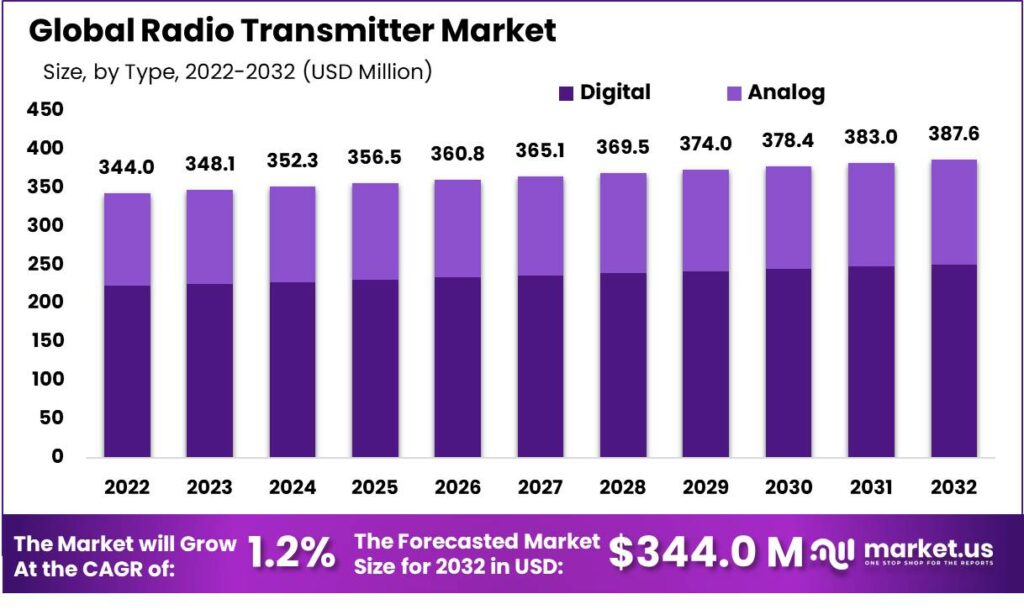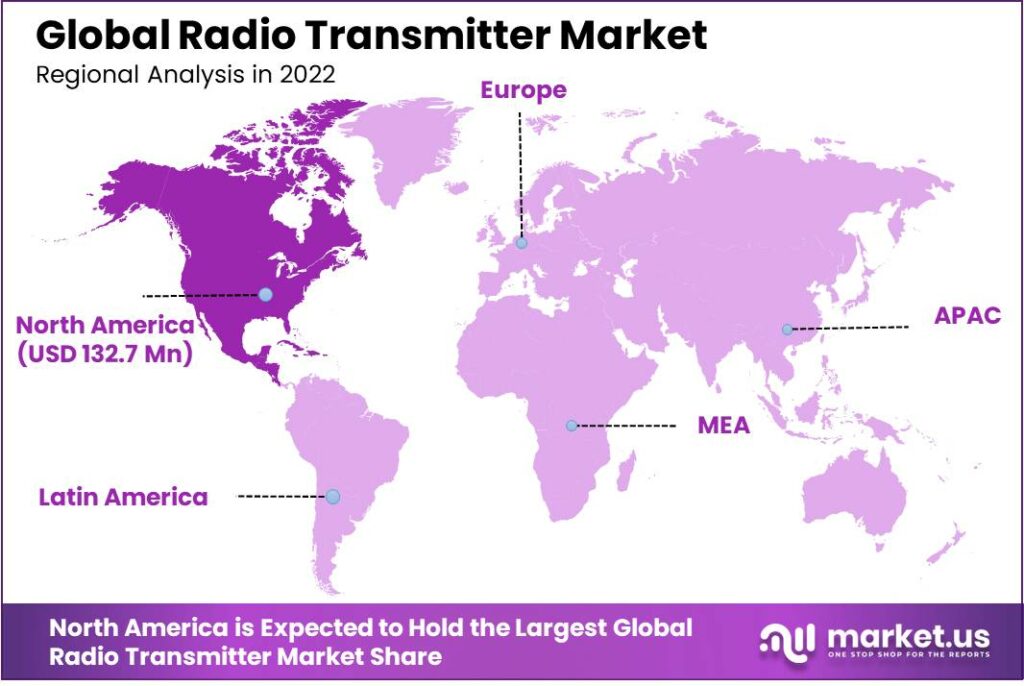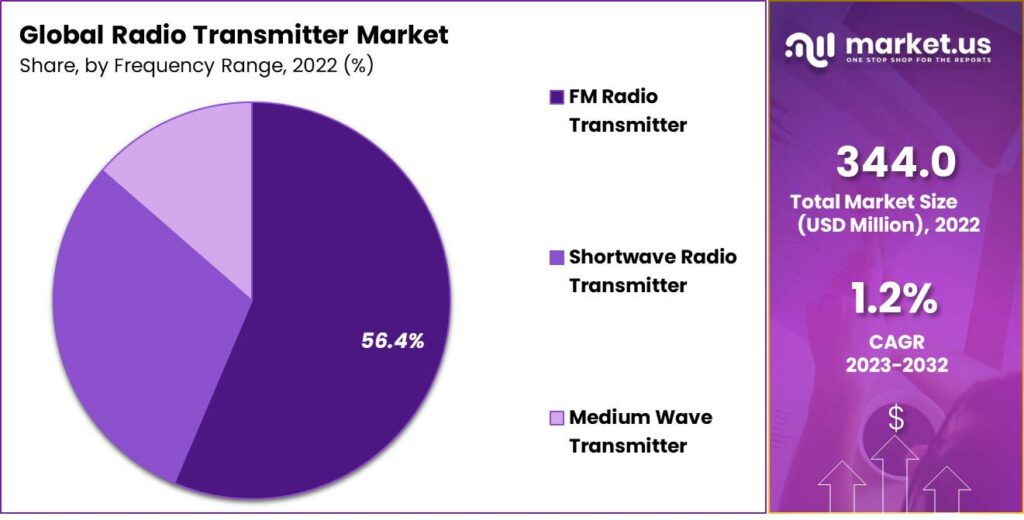New York, Sept. 27, 2023 (GLOBE NEWSWIRE) -- According to research conducted by Market.us Insights, the global Radio Transmitter Market is poised for significant growth, with an estimated valuation of USD 387.6 Million anticipated by the end of the assessment period. This growth is attributed to a robust 1.2% growth rate forecasted during the forecast period of 2022 to 2032.
Radio transmitters play a crucial role in producing, distributing, and selling devices that can transmit radio signals. They are electronic devices specifically designed to generate and emit radio waves, enabling the transmission of various types of information, including audio, data, and video. These devices find applications across various sectors, such as broadcasting, telecommunications, military and defense, navigation, and remote sensing.
The market for radio transmitters encompasses a wide range of companies, including both small-scale manufacturers specializing in niche equipment and large multinational corporations. Several factors impact this market, including technological advancements, regulatory changes, and the growing demand for wireless communication and broadcasting services.
Get a glance at the Radio Transmitter Market contribution of the segments, Request a PDF Sample

Key Takeaway:
- On the Basis of Type, digital radio transmitters lead the segment with a major revenue share of 64.8%.
- Based on Frequency Range, FM radio transmitter dominates the market with a major revenue share of 56.4%.
- On the Basis of End-Use Industry, the aerospace and defense industry holds a major revenue share of 36.4% to dominate the market.
- Based on Region, North America leads the market with a major revenue share of 38.6%.
- Asia Pacific will grow at the fastest CAGR rate from 2023-2032.
Factors Affecting the Growth of the Radio Transmitter Market
- Technological Advancements: Ongoing advancements in radio transmitter technology, including miniaturization and increased transmission efficiency, drive market growth by enabling more compact and powerful devices.
- Growing Demand for Wireless Communication: The proliferation of wireless communication in sectors like telecommunications, IoT, and automotive increases the need for radio transmitters, propelling market expansion.
- Public Safety and Defense Applications: Increasing security concerns and military modernization efforts boost demand for radio transmitters in critical applications like emergency services and defense.
Top Trends in the Global Radio Transmitter Market
SDR technology enables the flexibility to reconfigure radio functions via software updates, replacing traditional hardware-based systems. This trend streamlines radio transmitter design, making it adaptable for various applications, frequencies, and standards, reducing production costs, and accelerating time-to-market. SDRs find extensive utility in defense, public safety, and communication networks, aligning with the broader shift toward digitalization and connectivity. The adoption of SDRs not only enhances performance and versatility but also positions the market for sustained growth and innovation in an ever-evolving technological landscape.
Get deeper insights into the market size, current market scenario, future growth opportunities, major growth driving factors, the latest trends, and much more. Buy the full report here
Market Growth
The widespread deployment of 5G infrastructure requires advanced radio transmitter technology to support the increased data speeds and low-latency communication demanded by this next-generation wireless standard. As 5G networks continue to roll out globally, radio transmitter manufacturers witness heightened demand for their products to enable this high-speed connectivity.
Regional Analysis
The North American region leads the market by securing a major revenue share of 38.6%. North America is a region with a well-established and highly advanced broadcasting sector. It boasts a dense network of radio stations and significantly emphasizes adhering to digital broadcasting standards. This technological expertise is further boosted by the presence of leading radio transmitter manufacturers and dedicated research institutions, fostering a culture of ongoing innovation and development. North America's aerospace and defense industry heavily relies on radio transmitters for secure and reliable communication, resulting in a sustained demand for these critical devices. Additionally, the region's vibrant landscape of major broadcasting networks and media companies ensures a consistent and robust market for state-of-the-art transmitters. Collectively, these factors propel North America's substantial growth in the radio transmitter market.
The Asia Pacific region is also anticipated to grow at the fastest CAGR throughout the forecast period. The growth of the Asia Pacific region is anticipated to be driven by the growing demand for consumer electronics.

Competitive Landscape
The competitive landscape of the Market has also been examined in this report. Some of the major players include:
- Harris Corporation
- NEC Corporation
- Rohde & Schwarz
- GatesAir
- Nautel
- Elenos
- Broadcast Electronics
- Thales Group
- RIZ-Transmitters Co.
- Continental Electronics
- Thomson Broadcast
- Other Key Players
The report analyses the market size and growth and provides accurate predictions on the growth of the market. View FREE PDF Sample
Scope of the Report
| Report Attributes | Details |
| Market Value (2022) | US$ 344.0 Million |
| Forecast Revenue 2032 | US$ 387.6 Million |
| CAGR (2023 to 2032) | 1.2% |
| North America Revenue Share | 38.6% |
| Base Year | 2022 |
| Historic Period | 2016 to 2022 |
| Forecast Year | 2023 to 2032 |
Market Drivers
The continuous evolution of digital technology demands more efficient and adaptable transmitters to meet modern demands effectively. The increasing reliance on wireless communication necessitates top-notch broadcasting capabilities, creating a fertile ground for market expansion. Furthermore, the rising adoption of digital radio and its widening defense and emergency services applications contribute significantly to the market's upward trajectory. These dynamics and the persistent need for reliable and energy-efficient solutions paint a promising outlook for the market.
Market Restraints
Economic fluctuations have the potential to influence investments in broadcasting equipment, introducing a level of uncertainty into market growth projections. Additionally, the stringent regulatory demands of frequency allocation and licensing can delay product development and hinder the market's expansion. Further complicating matters is the emergence of alternative communication technologies, such as streaming services and podcasts, which pose a competitive threat by diverting both attention and resources away from traditional radio. Due to these factors, it becomes imperative for the industry to exhibit strategic adaptability to navigate the evolving landscape of the market effectively.
Market Opportunities
The increasing popularity of digital radio broadcasting is driven by its superior audio quality and interactive features, creating a significant growth opportunity. Due to the ongoing expansion of radio broadcast infrastructure, emerging markets in Asia-Pacific and Latin America provide ample untapped potential. Additionally, IoT and smart city initiatives are creating an increased need for reliable communication systems that support reliable wireless transmission, spurring their adoption in greater numbers. Furthermore, this industry benefits from ongoing innovations that produce energy-efficient transmitter solutions that meet ever-evolving sector demands.
Report Segmentation of the Radio Transmitter Market
Type Analysis
On the basis of Type, the market is classified into digital and analog. From these types, digital radio transmitters dominate the market by securing a revenue share of 64.8%. This growth of digital transmitters is due to digital transmitters excelling in audio quality and efficiency, aligning with evolving consumer and broadcaster demands. Global digitalization and analog-to-digital broadcasting shift boost the adoption of digital transmitters. Rising digital radio platforms and global broadcasting networks sustain digital radio transmitter growth, making them preferred by advanced, reliable communication providers and broadcasters.
Frequency Range Analysis
Based on Frequency Range, the market is classified into FM radio transmitters, shortwave radio transmitters, and medium wave transmitters. Among these frequency ranges, FM radio transmitters dominate the market by securing a revenue share of 56.4%. This growth of FM radio transmitters is owing to FM radio excels in high-quality audio, ideal for music and voice content, serving broad urban and suburban audiences. Its signal stability suits local areas, elevating its appeal. While shortwave and medium-wave serve niches, FM radio thrives as the primary choice for local and regional stations, reigning supreme in the market.

End-Use Industry Analysis
On the basis of the end-use industry, the market is classified into automotive, aerospace & defense, consumer electronics, and other end-use industries. Among these end-use industries, the aerospace and defense industry dominates the market, with a major revenue share of 36.4%. This massive growth is attributed to radio transmitters' pivotal role in secure, mission-critical communication in aerospace and defense. They serve military ops, air traffic control, and space exploration. High-performance transmitters are in demand due to advanced defense tech and complex communication systems. Satellite communications and UAVs drive market growth. Stringent reliability, durability, and encryption standards make radio transmitters integral to aerospace and defense operations.
Buy Now this Premium Report to Grow your Business: https://market.us/purchase-report/?report_id=15197
Market Segmentation
Type
- Digital
- Analog
Frequency Range
- FM Radio Transmitter
- Shortwave Radio Transmitter
- Medium Wave Transmitter
End-Use Industry
- Automotive
- Aerospace & Defense
- Consumer Electronics
- Other End-Use Industries
By Geography
- North America
- The US
- Canada
- Europe
- Germany
- France
- The UK
- Spain
- Italy
- Russia
- Netherland
- Rest of Europe
- APAC
- China
- Japan
- South Korea
- India
- Australia
- New Zealand
- Singapore
- Thailand
- Vietnam
- Rest of APAC
- Latin America
- Brazil
- Mexico
- Rest of Latin America
- Middle East & Africa
- South Africa
- Saudi Arabia
- UAE
- Rest of MEA
Recent Developments
- In September 2022, Rohde & Schwarz unveiled the R&S TH1 transmitter platform, a high-power liquid-cooled transmitter tailored specifically for UHF band applications. It features a software-defined operation that provides flexibility and functionality across all UHF bands.
- In July 2023, Rohde & Schwarz demonstrated sustainable broadcasting in a connected world by showcasing high-performance yet energy-efficient transmitters at NAB.
Explore More Related Reports
- Brazil Microwave Radio Market is projected to be US$ 231.5 Mn in 2018 to reach US$ 637.1 Mn by 2028 at a CAGR of 10.7%
- Current Transducer Market size is expected to be worth around USD 792.0 million by 2032, growing at a CAGR of 4.0%.
- Gas Detection Equipment Market was worth USD 4,454.4 million in 2021. It is projected to grow at a CAGR of 9.7%, between 2023-2032.
- Next Generation Memory Market size is expected to expand at a compound annual growth rate (CAGR) of 18.6% from 2023 to 2033.
About Us
Market.US (Powered by Prudour Pvt Ltd) specializes in in-depth market research and analysis and has been proving its mettle as a consulting and customized market research company, apart from being a much sought-after syndicated market research report-providing firm. Market.US provides customization to suit any specific or unique requirement and tailor-makes reports as per request. We go beyond boundaries to take analytics, analysis, study, and outlook to newer heights and broader horizons.
Follow Us On LinkedIn Facebook Twitter
Our Blog:
More Category-Wise Reports
- Information and Communications Technology Market Research Reports
- Semiconductor and Electronics Market Research Reports
